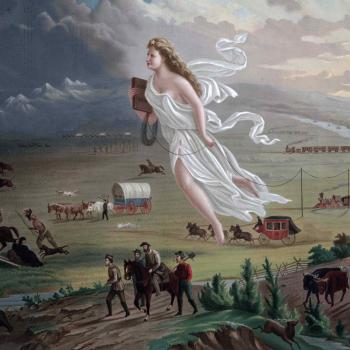No, that’s not a reference to the musical.
In recent weeks, I have posted several items concerning the historicity or literal veracity of the Book of Mormon, and have had some exchanges with Dr. Bill Hamblin at his blog (a debate that he suggested and initiated). You can see my latest (lengthy) contribution here:
http://www.patheos.com/blogs/enigmaticmirror/2015/07/03/jenkins-16-argument-turned-upside-down/
Once again, you will observe Dr. Hamblin’s scholarly approach in that he is not only hosting a debate like this, but also permitting his blog to be used to present strongly contrary views.
You can follow the whole story yourself, but if you have any interest in the topic, do read that post in particular. I am drawing attention to it here it here because it is so central to my case. Basically, this represents pretty much everything I have to say in these Book of Mormon arguments, and it is what I would refer to in answer to any and all future questions on these matters. If you think that anything that follows below is sketchy or skips over major points in an argument, that is because I am summarizing a much longer piece, so of course I am leaving out a great deal.
In very rough summary, using the customary ten point sequence:
1. Any discussion of historicity or literal truth has to focus first on the question of whether any or all of the peoples, societies and languages described in the Book actually were present in any part of the Americas at the time described. Every other issue and claim is subsidiary.
2. Given the lack of textual evidence, that has to be an archaeological question, rather than a subject for academic history. Of course, where contemporary texts survive, as in the case of the ancient Maya, then history and archaeology can and must be integrated, but otherwise, archaeology must take precedence. That observation determines the methodologies to be used.
3. Archaeology is a science, with well-established rules and principles. It is empirical in nature, and pursues familiar scientific practice in making and testing hypotheses. Any claims or statements must be testable, refutable and falsifiable. I describe at some length what these principles are, and how they work in practice within the realm of archaeology. Archaeology, like any discipline, also has clear standards about what claims can be considered credible: generally, this implies peer-reviewed publication.
Evidence cannot be considered if it is merely anecdotal or impressionistic. There’s no point citing vague, generic “parallels” that supposedly exist between Old and New Worlds.
4. The far-reaching statements made by the Book of Mormon about the New World stand in stark contrast to any kind of scholarly consensus in any recognized discipline whatever, doubly so because of the wholly supernatural claims on which they are based. They are therefore extraordinary in nature, and demand high standards of proof. Evidence must be subject to the strictest criteria outlined above: it must be testable, refutable and falsifiable.
5. Also because of this extraordinary quality, any statements made in support of the Book of Mormon’s historicity must be positive in nature, in the sense that specific claims must first be advanced by believers for testing and verification. The burden of proof is wholly on the claims-makers. Non-believers are not required to do anything in order to disprove statements made by the Book.
6. I have made a great many repeated requests for any proposed piece of credible, objective evidence of this kind that might be subjected to such a process to testing and verification.
Far from requesting comprehensive proofs of the whole Book – an impossible task – I have requested merely one single piece of credible evidence that might confirm the Book of Mormon’s account of the New World. As examples, I have cited the kind of items that are so regularly used by archaeologists, such as architectural remains, inscriptions, metalwork, pottery, weaponry, and so on. I am of course defining the realm of archaeology widely, so that evidence derived from genetics or linguistics would also be welcome.
7. To date, I have never received or seen even the hint of any such credible, positive evidence concerning the New World.
8. In the total absence of such evidence, it is impossible for any debate to proceed. We must hold to the default position that the Book of Mormon was entirely composed by an American author in the early nineteenth century. It has no validity whatever as a picture of the pre-Columbian Americas.
9. My conclusion to Dr. Hamblin is therefore as follows: Without such positive, objective, verifiable evidence – evidence subject to the rules and conditions that I have laid out here – then you have zero grounds to support or advocate the historicity of the Book of Mormon other than religious faith, which is not susceptible to academic discussion or examination.
10. Ergo, we cannot even speak of a debate or controversy about the historicity of the Book of Mormon. The Book is a product of religious faith, and must be received on the basis of religious faith. It has nothing to do with scholarship.
…
Those ten points represent a minimal statement of my case.
Personally, I would add that it is inconceivable to me that such a supposedly mighty and long-lasting civilization as that portrayed in the Book of Mormon (a thousand years) should have vanished without leaving any traces whatever, whether material, genetic or linguistic. I just don’t believe it, and I say that on the comparative basis of looking at a great many civilizations and cultures worldwide. The lack of genetic evidence in particular is utterly damning. Nor am I convinced by any arguments I have yet seen that attempt to explain or account for these enormous and telling absences.
In the context of this present argument, though, my views on that subject are superfluous, as I have no obligation to produce any evidence whatever, whether positive or negative. I don’t have to make a case. As I have said, the burden of positive proof is wholly and entirely on the claims-makers.
I also reiterate one key passage in my text:
I stress these criteria and particularly their origins, so that you (and your readers) can see that I am not inventing them out of whole cloth. I am in no sense trying to invent special rules to apply to the Book of Mormon that I would not apply to other topics or eras. These are fundamental principles of science in general, and of social science in particular.
…
Finally, I have responded to Dr. Hamblin’s most recent post here:
http://www.personal.psu.edu/faculty/j/p/jpj1/akish.htm
….
Can I reiterate one thing? Before you comment on anything, PLEASE read the full post at Dr Hamblin’s site, not just this summary, which is bare bones. That full document is, once again, at
http://www.patheos.com/blogs/enigmaticmirror/2015/07/03/jenkins-16-argument-turned-upside-down/
















